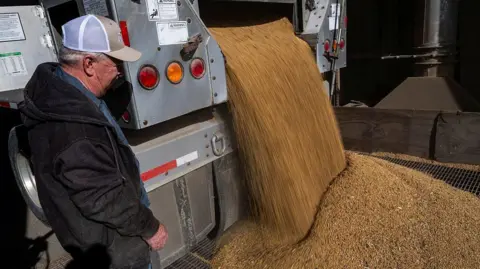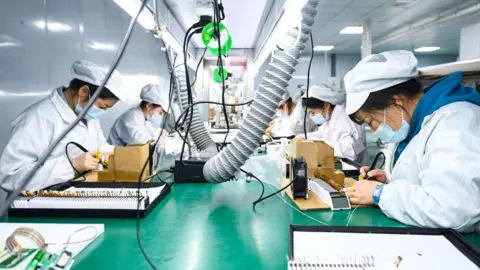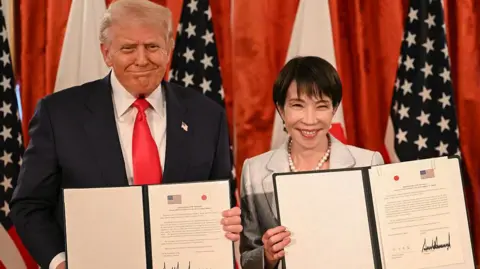Osmond ChiaBusiness reporter
US President Donald Trump and Chinese leader Xi Jinping held a high-stakes meeting on Thursday that appears to have put both countries on the path to a trade deal.
Trump told reporters onboard Air Force 1 after the talks that the meeting was “a great success” and the US would sign a deal with China “pretty soon”.
The world’s two biggest economies are competing over everything – from tit-for-tat tariffs, to access to the rare earth minerals and semiconductors that underpin advanced manufacturing.
Trump said he would lower tariffs on China, and that US access to rare earths had been settled. He added that Beijing would talk directly to chip designer Nvidia, while the US served as a “sort of a referee”, without providing much more detail.
Beijing’s response – in the form of an official readout – was more vague. It didn’t say too much beyond the fact that they had reached a consensus to resolve “major trade issues”.
Trump said they had “come to a conclusion on many important points”, which will be announced soon.
But there has been no word yet on the sale of Chinese-owned TikTok’s US operations, which analysts were expecting to be finalised during these talks.
It took 10 months – of retaliatory tariffs, a shaky truce, uncertainty for manufacturers and businesses world over – for Trump and Xi to meet.
“This is the meeting that resets globalisation in a post-Covid era,” according to economist Prof Tim Harcourt from the University of Technology Sydney.
So, how did we get here?
Tit-for-tat tariffs – and a truce
Trump kicked off his trade war with China well before “Liberation Day” in April – the date on which he unveiled levies on most countries, hitting both allies and foes.
China has long been in his crosshairs – for what he described as unfair trade practices – and was hit with tariffs in his first term too.
Early in his second term, in February, he announced 10% tariffs on all Chinese imports in – on top of those that already existed from his previous term.
Beijing shot back with its own levies, and Trump responded again, taking US tariffs on China to 20% .
And then on “Liberation Day” Trump threatened China with an additional 34% levy. The tit-for-tat measures continued, with US tariffs reaching 145%, while Chinese levies touched 125%.
The staggering numbers left manufacturers and importers reeling and uncertain. Stock piled up in warehouses in China, as alarmed American businesses wondered how to find alternate supply chains overnight.
 Getty Images
Getty ImagesMeanwhile, Trump’s global tariffs offensive also took aim at “transshipments” – Chinese-made goods that were being re-routed through other countries, such as Vietnam.
But Beijing did not back down. China was open to dialogue, it said again and again. But just as clear was that it was willing to take the pain.
It also managed to inflict pain. For instance, it targeted a key vote base of Trump’s – farmers – when it began heaping levies on American agricultural imports, such as soybeans.
Trump’s attempts to cut off US companies, from Apple to Walmart, from Chinese manufacturing were also weakened by exemptions – and that, in turn, boosted Beijing’s confidence.
In May, the two sides struck a fragile truce, agreeing to keep talking until they had a final deal.
The battle for chips
Even as the tariff talks continued, another sticking point in the US-China relationship returned: the fight over advanced chips, which go into everything from smartphones to AI applications.
They are essential for China’s plan to transform its economy from the “world’s factory” for basic products to the home for cutting-edge tech. And experts largely agree that despite huge talent, China’s semiconductor industry trails behind that of the US.
The White House has been trying to limit China’s access to the most advanced chips. This was happening even before Trump, but his administration has held on that tight leash, allowing only less-advanced semiconductors to be shipped to China.
At the heart of this strategy has been Nvidia, the world’s most valuable company – the chips it designs are widely regarded by the industry as the gold standard. China is a big enough market – earning it billions – that the firm even agreed to pay the US government 15% of its China sales in return for export licenses.
But Beijing then surprised the US by reportedly telling local firms not to buy from chips from America. Instead it rallied its industries around domestic manufacturers like Alibaba and Huawei.
Beijing also launched an anti-monopoly probe into Nvidia.
 Getty Images
Getty ImagesThe measures underline what Beijing has long intended: to become more self-reliant, China policy analyst Stefanie Kam from the S Rajaratnam School of International Studies says.
It has been investing heavily in tech and AI, encouraging firms to innovate and make big bets. This ability to use “state-craft” to rally specific sectors of the economy is partly what has made China appear more resilient during the negotiations with the US, she adds.
China is playing the long game, analysts believe – so rather than rush into a deal which may or may not last, it is investing in building industries that are less reliant on the West.
The other battle – for rare earths
But its decision to play a long game doesn’t necessarily mean China doesn’t want a deal with the US.
There are limitations to Beijing’s powers, says Prof Harcourt, noting its economic challenges at home, including unemployment, weak spending and a property crisis.
China’s leadership isn’t constrained by democratic elections but it still faces pressure to keep its middle-class prosperous and ensure political stability, he noted.
“Washington would be fully aware of China’s domestic difficulties… There is still pressure on China and they wouldn’t want a long-term severe trade war.”
What Xi does want is to be able to walk into the talks with a strong hand. And so in October, China went on the offensive by tightening controls over rare earth exports.
The country has a near-monopoly in the processing of the critical minerals that go into electronics, green energy tech and military equipment like fighter jets.
It was a pivotal moment in the trade war.
The US’s tech curbs threaten to slow China’s progress, but restricting rare earths could halt entire industries, says Naoise McDonagh from Australia’s Edith Cowan University.
 Getty Images
Getty ImagesThe Chinese announcement on rare earths stunned the White House. Especially because it came after Trump said that the two sides had reached an agreement on the sale of TikTok’s US business. A top US trade official called it a “betrayal” of the US-China truce.
The move served as a stark reminder of American dependence on Chinese resources. And it prompted a series of agreements between the US and Australia, Malaysia and Japan, all focused on US access to rare earths – a form of “insurance” for Washington to get hold of the minerals outside China, according to Prof Harcourt.
These deals happened as Trump and US negotiators sought to ease tensions with Beijing, and met with Chinese officials to set up Thursday’s meeting.
The differences are huge, and the rivalry runs deep but “there are lower-hanging fruits”, according to Prof Kam, such as China delaying its rare earth export curbs in exchange for lower tariffs.
However fragile a deal might be, it could “narrow the risk” of any unexpected decisions in the months ahead, Prof Kam adds.
But experts warn that no truce between the US and China will last forever.
Disclaimer : This story is auto aggregated by a computer programme and has not been created or edited by DOWNTHENEWS. Publisher: BBC







